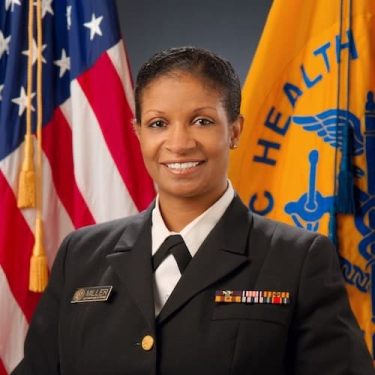
A profile of Dr. Jacqueline Miller, MD, FACS, Medical Director of the CDC’s National Breast and Cervical Cancer Early Detection Program in the Division of Cancer Prevention and Control.
October is Breast Cancer Awareness Month and there is much to celebrate this year. According to the American Cancer Society, the 5-year relative survival rate for localized breast cancer, cancer that has not spread outside the breast, is 99 percent. For those whose cancer has spread outside the breast to nearby structures or lymph nodes, the survival rate is 86 percent.
A 2010 study conducted by the non-profit Breastcancer.org on the survival rates of the University of Texas’s MD Anderson Cancer Center’s patients reported that the hospital’s survival rate for breast cancer from 1944-1954 was only 25 percent.
“The reason for the low survival rates in the 1940s and 1950s was due to the lack of routine screening protocols and limited treatment options,” said Dr. Jacqueline Miller, MD, FACS, Medical Director of the CDC’s National Breast and Cervical Cancer Early Detection Program (NBCCEDP) in the Division of Cancer Prevention and Control. “Women were often diagnosed with breast cancer after the tumor(s) had gotten very large. At that point, the chance of long-term survival was pretty low.” “Early detection and advances in treatment,” Dr. Miller emphasized, “are what led to the amazing survival rates seen today.”
Jacqueline Miller, MD, FACS, is a board-certified general surgeon and a Captain with the U.S. Public Health Service. She attended Spelman College in Atlanta, Georgia for her undergraduate education and earned her medical degree from Washington University School of Medicine in St. Louis, Missouri. She then completed an internship and residency in general surgery at the University of Mississippi Medical Center in Jackson, Mississippi. After completing her training, she practiced general surgery for eight years in Atlanta with a special interest in breast cancer.
Dr. Miller later joined the Centers for Disease Control and Prevention as an Epidemic Intelligence Service Officer in the Division of Adult and Community Health. Currently, she is the Medical Director for CDC’s National Breast and Cervical Cancer Early Detection Program in the Division of Cancer Prevention and Control. She has authored or co-authored more than 90 publications and mentors fellows training in epidemiology. Dr. Miller continues providing clinical care in an outpatient clinic setting.
As we celebrate National Breast Cancer Awareness Month 2022, we are fortunate to have Dr. Miller’s perspective on the advances in breast cancer treatments, survival rates, and the excellent work she spearheads as Medical Director of CDC’s National Breast and Cervical Cancer Early Detection Program (NBCCEDP).
The NBCCEDP was created by Congress through the Breast and Cervical Cancer Mortality Prevention Act of 1990. The Program aims to improve access to breast and cervical cancer screenings for women living at or below 250 percent of the poverty line, who are uninsured, or whose insurance does not cover cancer screenings and diagnostic care.
Since its inception, the NBCCEDP has served more than 6 million women, provided more than 15 million breast and cervical cancer screenings, and diagnosed 75,961 invasive breast cancers and 24,024 premalignant breast lesions.
The COVID-19 pandemic caused many women to skip their regularly scheduled mammograms. Yet, despite the challenges of COVID-19, in 2021, the NBCCEDP and its partners provided breast cancer screening and diagnostic services to 253,972 women, of which 2,374 were diagnosed with invasive breast cancers, and 696 were diagnosed with premalignant breast lesions.
“Early detection through services such as mammograms can help women find breast cancer early, when treatments have tremendous success rates,” Dr. Miller states. One such NBCCEDP-funded program is the Best Chance Network in South Carolina. Over the past 29 years, the state’s screening program has worked to establish strong partnerships to reach eligible women, educate them on available services, and get them screened. Through creative partnerships and technological innovations, the Best Chance Network has screened about 135,000 women and found more than 1,600 invasive breast cancers, 550 pre-cancers, and 4,300 invasive cervical and pre-cervical cancers. The program worked with the non-profit Closing the Gap in Healthcare to explain the importance of cancer screening at minority-owned barber shops and beauty salons and partnered with several stores to host mobile screenings. It also partnered with the South Carolina Witness Project, a faith-based organization that provides information to African American women on cancer risk factors and recommends cancer screening tests, and the South East American Indian Council, Inc., to reach the women of the Catawba Indian Nation and statewide non-federal Tribes. Rescreening rates in South Carolina increased from 46 percent in 2015 to 65 percent in June 2020.
Other successful NBCCEDP-funded programs include: the Guam Breast and Cervical Cancer Early Detection Program, through which two-thirds of all their patients are screened at a Saturday clinic, and the Arctic Slope Screening for Life Program in Alaska, which provides screenings for women on their day(s) off.
The NBCCEDP currently funds award recipients in all 50 states, the District of Columbia, 2 U.S. territories, 5 U.S.-Affiliated Pacific Islands, and 13 American Indian and Alaska Native tribes or tribal organizations. During 2016–2017, about 5.3 percent of U.S. women were eligible for the program’s breast cancer screening services, which served 15 percent of those eligible. Dr. Miller added, “One of our biggest goals for the NBCCEDP is to reach more women eligible for these services and to engage them to take advantage of these vital services.”
As we acknowledge Breast Cancer Awareness Month, the NBCCEDP is on the leading edge, working to reach the women eligible for its cancer screenings to detect breast cancer early and beat it. Click here to find a program near you!

